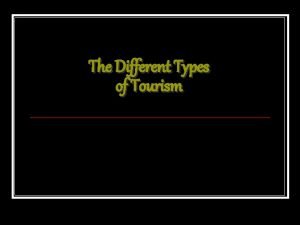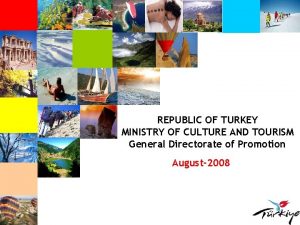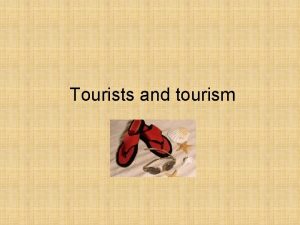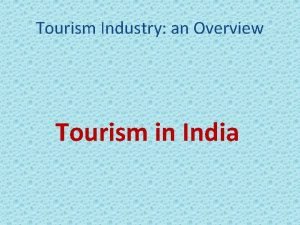The Demonstration Effect Unit 4 Tourism and Culture















- Slides: 15

The Demonstration Effect Unit 4: Tourism and Culture

The Demonstration Effect • Too often control of the tourism industry lies in the hands of foreign companies whose interest lies in profit. • The impact of tourists’ values and custom on local people is known as the DEMONSTRATION EFFECT. • The demonstration effect can occur several different ways.

The Demonstration Effect • Economic benefits from tourism are not always a positive experience for a tourist destination. • The destruction of the natural environment is an easily seen impact, but cultural impacts are harder to detect. • Culture is a major selling point for tourism and sometimes cultural traditions must be sacrificed to an extent for economic profit.

Commodification • Commodification occurs when traditional rites, souvenir, arts or festivals lose their cultural meaning in order to sell the experience to tourists. • Festivals, shows, religious ceremonies are staged for cash, so that tourists can experience the local culture without understanding the cultural significance. • Local souvenirs, music, arts, and crafts also change to meet tourist demands.

Commodification • Production of the above may be cheaper to mass produce in a different country rather than rely on the product being made locally in order to meet tourist demands. • However the benefit of commodification is the influx of money, the creation of jobs and the multiplier effect of tourist dollars on a region. • Thus the destination is left with a problem— do you sacrifice culture for profit?

Standardization • STANDARDIZATION of cultural tourist areas means bringing recognizable features such as food, hotels, and movies to exotic destinations to make the tourist feel more comfortable in their surroundings. • Standardization also means taking a culture and changing it to appeal to the tourists.

Standardization • A local delicacy in Korea, which may contain dog meat, may be left off the hotel menu to appease North American tourists who would find this upsetting. • Although this type of meat is acceptable and normal to the Korean diet, it is not to North Americans. • Once again, the local culture is left with a problem—how much of the culture must be changed to meet the tourists’ demands?

Transculturation • The physical landscape of a cultural area can be commercialized or developed to meet the needs of tourists. • Large scale tourist developments can also affect nearby areas through increased tourist traffic, possible increased crime levels, land use competition between the development and the traditional way of life also occurs.

Transculturation • Access to cultural land by residents can be restricted for tourist development. • Bali, Indonesia has seen the prime agricultural land; beach fronts and water supplies disappear to hotels and golf courses.

Transculturation • Local residents also see their traditional way of life come under threat. • Seasonal work patterns change to meet the tourist season. • In Atlantic Canada, more money is made by boats taking tourists to see whales than catching fish in some seasons. • This change in employment means the potential loss of skills for future generations.

Transculturation • TRANSCULTURATION occurs most often with the young people of an area. • They are influenced and want to copy the behaviour and lifestyle of the tourists by the clothing, the music, the products and language used by the visiting tourist and over time it can be reflected in the local culture.

How can culture be protected? • Educating tourists on the cultural importance and meaning of festivals or attractions can allow tourists to more fully appreciate the culture of an area. • Tourists can also prevent cultural problems by educating themselves about the culture of the area they visit. • In Muslim countries, Muslim women have to be extremely careful of how they cover themselves in public.

How can culture be protected? • Female tourists must by aware that by wearing shorts, skirts, or bathing suits, they are disrespecting the local culture. • There is the fear that by appearing in this dress, tourists can influence locals to follow their lead and thus create tensions within the community. • Residents can be involved in this process which gives them a sense of control in protecting their culture.

How can culture be protected? • The physical landscape that contains cultural features should be planned to allow both protection and allow for growth. • Effective land use planning, such as designated tourism development areas or zones, will prevent problems such as overcrowding and conflicting interests later on.

How can culture be protected? • This will only work as long as all stakeholders (residents, cultural leaders, tourism sector) have input into the decision making process. • Rushed development of the tourism industry brings potential profits and the cultural landscape of an area into conflict. • By developing the tourism sector in an area gradually, the previous solutions can be implemented effectively.
 Demonstration effect in economics
Demonstration effect in economics Demonstration effect in economics
Demonstration effect in economics Demonstration effect in tourism
Demonstration effect in tourism Mass tourism vs alternative tourism
Mass tourism vs alternative tourism Republic of turkey ministry of culture and tourism
Republic of turkey ministry of culture and tourism Unit 12 responsible tourism
Unit 12 responsible tourism Multiplier effect in economy
Multiplier effect in economy What is cultural relativism
What is cultural relativism Batch culture vs continuous culture
Batch culture vs continuous culture American vs indian culture
American vs indian culture Uses of selenite f broth
Uses of selenite f broth Folk culture and popular culture venn diagram
Folk culture and popular culture venn diagram Examples of mass culture
Examples of mass culture Composite media in microbiology
Composite media in microbiology Folk culture and popular culture venn diagram
Folk culture and popular culture venn diagram Pour plate method
Pour plate method




























